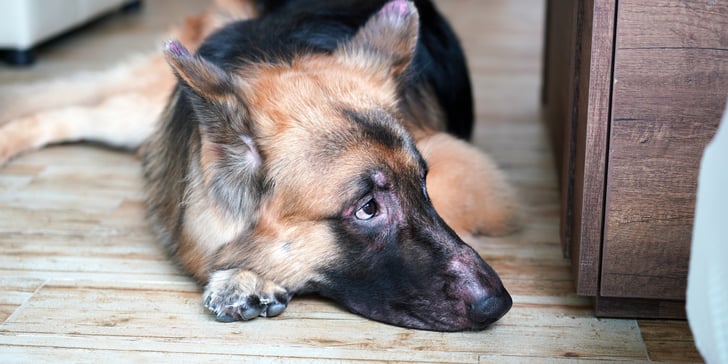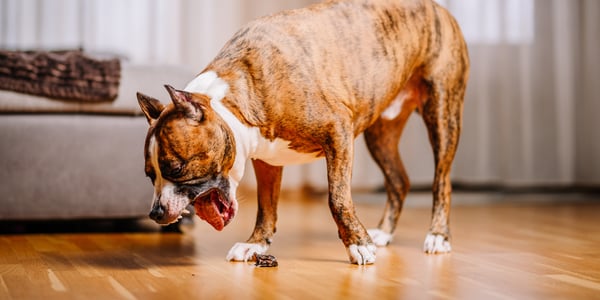What is Dog Bloat? - Understanding GDV and How to Prevent It
Index:



Introduction
As pet owners, few things are more heart-wrenching than witnessing our furry companions in distress or pain.
Understanding Gastric Dilatation-Volvulus, also known as GDV is crucial. This serious condition, where a dog's stomach fills with gas and twists upon itself, can quickly become life-threatening.
Acting swiftly by getting your pet to a veterinary surgeon immediately could make the difference between life and death.
By educating ourselves, recognising the signs of bloat and understanding the risk factors is essential to help prevent this condition.
Key takeaways:
Recognise the signs of bloat and understand the immediate dangers.
Gastric Dilatation-Volvulus (GDV) requires instant veterinary attention.
Know the risk factors, especially in large and deep-chested dog breeds.
Preventive measures, including appropriate feeding techniques and stress minimisation, are vital.
Consult your vet about preventive strategies, including gastropexy surgery for high-risk dogs.



What is Dog Bloat? Understanding GDV
Gastric Dilatation-Volvulus (GDV) represents a serious and potentially life-threatening scenario for our canine companions.
Commonly occurring in large breed dogs with deep chests, this condition starts when the stomach fills with gas, known as 'bloat.'
As bloat happens, the stomach may twist, leading to a condition called 'volvulus,' blocking both entrances and exits of the stomach.
This obstructs blood flow and compromises the stomach wall, necessitating immediate veterinary attention for effective treatment of bloat.
Causes of GDV
Despite extensive research, the exact causes of bloat in dogs remain uncertain. Factors such as stress, anxiety, rapid eating, high fluid intake, and rigorous exercise post-meal are all believed to be contributory elements.
Moreover, underlying illnesses impacting gut motility are also suspected to play a role.
Owners of certain breeds of larger dogs with deep chests need to be particularly mindful, as these are more predisposed to develop bloat.
Symptoms of bloat in Dogs
Recognising the symptoms of bloat in dogs swiftly can drastically improve their survival rate. The severity of bloat often presents with noticeable signs:
Enlarged, distended abdomen
Unproductive retching or attempts to vomit
Pacing and restlessness
Excessive drooling
Laboured breathing
The stomach wall stretching and associated discomfort trigger these behavioural changes.
As bloat occurs, recognising these symptoms and seeking immediate veterinary intervention is crucial.
Risk factors
Several risk factors elevate the probability of GDV in dogs.
Large breed dogs with deep chests, such as Great Danes and German Shepherds, are disproportionately affected.
Additionally, males and canines with a familial history of GDV possess a higher risk.
Understanding these risk factors can help owners take preventive measures to reduce the likelihood of their furry friends developing bloat.



Preventing dog bloat: Tips and strategies
Integrating specific strategies into your pet care routine can help prevent bloat and ensure your dog's wellbeing.
Proper feeding techniques
Effective feeding methods play a crucial role in the prevention of bloat. To reduce the risk of bloat, provide smaller, more frequent meals instead of a single large meal.
Utilising puzzle feeders or licky mats can slow down rapid eaters, which helps in preventing bloat.
Also, avoid allowing your dog to engage in vigorous exercise immediately before or after eating.
Minimising stress
Stress is a substantial factor linked to GDV. Ensuring that your dog’s mealtime is calm and relaxed can help prevent stress-related bloat.
Feed them in a quiet space away from other pets and disturbances. Stress reduction strategies like regular exercise, mental stimulation, and maintaining a consistent daily routine also contribute to the prevention of bloat. Here are some tips to keep your dog happy and reduce stress.
Utilising products designed for dogs with anxiety can also help in reducing stress levels and preventing bloat.
Prevention of bloat with surgery
For dogs with a high predisposition to GDV, such as certain large and deep-chested breeds, a proactive surgical option can be considered.
A gastropexy procedure, which involves attaching the stomach to the body wall, can significantly reduce the risk of bloat.
Although surgery to prevent bloat does not eliminate the possibility of gastric dilatation, it does prevent stomach torsion (stomach twists).
In cases where you suspect bloat, immediate emergency surgery is vital to assess the damage caused by the lack of blood flow and to save the dog's life.



Final thoughts
Understanding the serious nature of Dog Bloat, or GDV, is essential for every dog owner, particularly for those with deep-chested breeds like Great Danes.
Recognising the signs and symptoms of bloat in dogs, such as a swollen abdomen, unproductive retching, and laboured breathing, is crucial.
Early identification and prompt treatment for GDV are vital to preventing complications that could necessitate life-saving surgery, such as tacking the stomach to the inside of the abdomen.
It’s always important to understand other health issues for early detection of various health concerns.



FAQs
What are the signs of bloat in dogs?
Signs of bloat in dogs include an enlarged abdomen, unproductive retching, pacing, and laboured breathing.
If you suspect your dog is suffering from bloat , it may necessitate immediate veterinary attention as this indicates a potentially life-threatening condition.
What causes bloat in dogs?
While the exact cause of bloat in dogs remains unclear, factors such as stress, anxiety, rapid eating, exercise after consuming a large meal, or excessive water intake, and underlying illnesses that reduce gut motility may contribute to its development.
What should I do if I suspect my dog has bloat?
If you suspect your dog has bloat, it is crucial to seek immediate veterinary assistance. Every minute without treatment increases the risk of severe complications, including the need for emergency surgery.
What does the treatment for GDV involve?
Treatment for GDV usually involves emergency surgery to untwist the stomach and return it to its normal position.
The procedure often includes a gastropexy, where the stomach is attached to the abdominal wall to prevent future occurrences.
Prompt treatment and post-operative care are essential for the dog's recovery.
Waggel Pet Insurance
Need more help? You're in luck if you're a Waggel Pet Insurance member. Along with our excellent coverage, we offer access to a 24/7 online vet to answer all your sticky questions, especially if you need grooming assistance.
Not a member? Why not get a quote now and cover your furry friend for a range of illnesses, all while enjoying our amazing perks and rewards.
Want more like this?
Get updates from us with helpful info, advice, answers to frequently asked questions and much more.
Index:
Related posts:
Get your quote
Along with our excellent coverage, we offer access to a 24/7 online vet to answer all your sticky questions.





